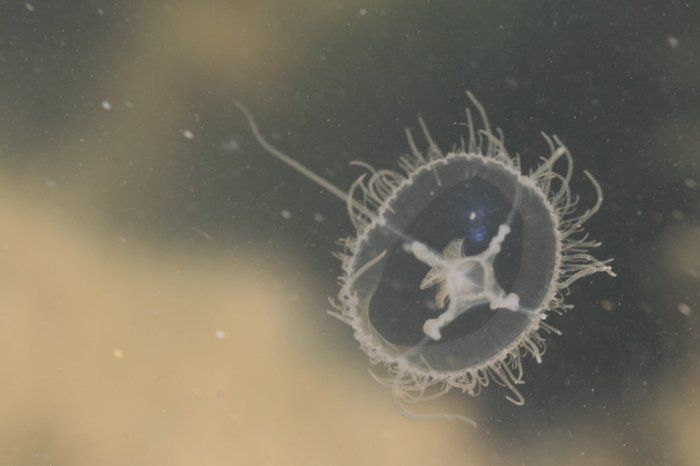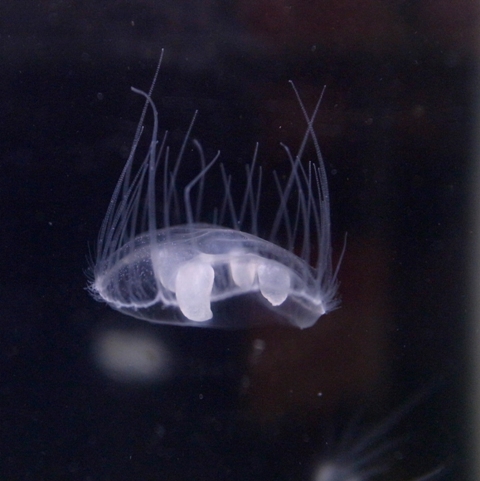Key to Australian Freshwater and Terrestrial Invertebrates
Phylum Cnidara
Class Hydrozoa
Families Oliniidae & Austromedusidae
(hydromedusoid forms)
Common names: freshwater jellyfish, bell-shaped jellyfish, hydromedusae
Overview
Hydromedusoid Hydrozoa look like �true� (or medusoid) jellyfish of the exclusively marine class Scyphozoa. Hydromedusans differ from scyphozoan jellyfish by a thin, shelf-like membranous structure called a velum attached to the bell margin on the ventral surface. Freshwater jellyfish are relatively transparent with a whitish or greenish tinge, umbrella-shaped and have many fine tentacles hanging down around the bell margin. The tentacles contain stinging cells, or �nematocysts�, which are used for defence and to capture food. Jellyfish swim by contracting a ring of muscles close to the edge of the animal and creates a slight increase in water pressure beneath the animal that propels it upwards. Freshwater jellyfish in Australia are small, growing to a maximum of 25mm in diameter with short tentacles about 2cm long.
Distribution and diversity
There are around 2,700 living species of hydrozoans. Only two species from two families of hydromedusoid jellyfish are known from Australian inland waters. One is the cosmopolitan Craspedacusta sowerbyi (Olindiidae), which is found throughout the world. It was first recorded near Adelaide in 1950 and is now widely distributed across the continent. The species is also widespread across New Zealand. The endemic Australomedusa baylii (Austromedusidae) is known only from saline lakes in Victoria and South Australia.
Life cycle
Jellyfish have a complex life history that involves an alternation between two reproductive stages, one sexual (a free-swimming medusa) and one asexual (a sessile polyp). Jellyfish produce eggs and sperm that are released into the water. Fertile eggs develop into larvae that hatch into polyps that live in colonies attached to underwater vegetation, rocks, or tree stumps. These polyps produce several segments, each of which develops into a small jellyfish. When development is complete, it detaches from the polyp and begins its life as a tiny planktonic jellyfish. The life cycle is typically dictated by seasonal changes and during the cold winter months or other unfavourable conditions, polyps contract and become resting bodies called podocysts, which can be transported to other bodies of water by aquatic plants or animals. Once conditions become favourable, they develop into polyps again.
Feeding
Hydrozoa are predaceous, feeding on tiny aquatic animals such as zooplankton, small crustaceans, insects and other invertebrates, even newly hatched fish. Prey are captured by their dangling tentacles that are armed with numerous stinging nematocysts which are sensitive to touch and automatically fire dart-like threads containing neurotoxins into whatever triggered their release. Once embedded in the flesh of its prey, poison is injected which paralyses it. The tentacles pass the prey to the mouth where it is consumed whole. Indigestible remains are expelled through the mouth.
Ecology
Olindiidae and Australomedusidae are free-floating, planktonic, solitary jellyfish. Craspedacusta sowerbyi may be found floating near the surface of large, still water bodies such as freshwater lakes and reservoirs. They have also been recorded from rivers and creeks. Australomedusa baylii is known only from saline lakes in Victoria and South Australia. Unlike several marine species, freshwater jellyfish do not pose a hazard to human swimmers. Elsewhere, studies have suggested the presence of the invasive C. sowerbyi has the potential to significantly alter native zooplankton communities and aquatic food webs via both direct predation of small zooplankton and incidental mortality of larger zooplankton and small fish. Overpopulation of a body of water by this species has also been shown to decrease the oxygen level in the freshwater community causing the death of other aquatic organisms.








